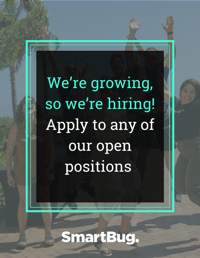
What’s a Get-to-Know-You Call, and How Do They Keep Remote Teams Connected?
February 21, 2022
By Sandy Moore
Here at SmartBug, we have an ongoing tradition for new employees: the “get-to-know-you” (GTKY) call. These calls are a fun way for new employees to meet their fellow coworkers.
As a remote team, this is a great opportunity for employees to stay connected with one another and build meaningful relationships.
What Exactly Is a Get-to-Know-You Call?
As a new employee, you’ll have a task to schedule GTKY calls with current team members, and as a current employee, you’ll join them when scheduled.
Typically these calls last between 15-30 minutes and there is only one rule for the call: Don’t talk about work! These calls are meant to help employees get to know each other on a more personal level.
It is best if the calls are conducted as video calls using platforms such as Zoom, Google Meet, or Slack, where you get to chat about anything and everything while seeing each other’s facial expressions. Depending on the size of your company you can choose to have calls that are done on a one-on-one basis or in a small group setting.
How to Schedule Get-to-Know-You Calls
New employees should have time set aside within their work schedule to participate in GTKY calls. Based on our experience, try not to schedule more than one GTKY call per day—otherwise you’ll get burned out and not enjoy them. That means that you wouldn’t schedule more than five calls per week.
Scheduling individual calls within a large organization can be a bit overwhelming, so it may be best to put together a prioritization process for GTKY calls. One option is to schedule calls with immediate team members first, while non-immediate team members could be determined as optional. You may also want to schedule calls with employees who have the same job title to gain more insight into your role at the company.
When scheduling GTKY calls, refer to your organization's shared employee calendar. Employees should have their work hours indicated on their calendar to display when they are available. As a courtesy to your fellow employees, don’t schedule calls outside of their working hours within their specific timezone. Another convenient way to schedule calls is to spend an additional 15 minutes after a work meeting to chat with someone you haven’t met before.
How to Conduct a Get-to-Know-You Call
It is best to set some guidelines for GTKY calls so employees have an idea of what to discuss, since they can chat about anything but work!
Here at SmartBug, we ask new employees to create bios to share with the entire company. These bios include both information about their personal and professional lives. Before a GTKY call, we encourage team members to review each other's bios and see what they may have in common.
In addition, we outline ideas of what to discuss during the calls. Here are some ideas of things to talk about during your GTKY calls:
- Do you have any hobbies? What do you do in your free time?
- Where do you live? What things do you like about your area?
- Tell me about your role.
- Do you have kids? Spouse? What do they do for work? What does your family like to do in their free time?
- Do you have fur babies? How many? What do they enjoy?
- Have you worked remotely before?
- What Slack channels are you a part of? Which is your favorite?
- What are you passionate about?
- What Netflix shows are you currently watching?
- What books are you currently reading?
- What's the latest vacation you went on? What's your favorite place you've traveled to? What trips do you have planned?
- What food do you like? What's your favorite recipe?
- How did you meet your partner?
- What's your favorite type of candy? Breakfast food?
- How do you pronounce the word GIF?
- What was your favorite concert you ever attended?
- What posters were on your wall as a kid?
The most important thing is to have fun and build relationships with your coworkers. This is especially important for remote teams that don’t see each other in person every day.
Ways to Implement Get-to-Know-You Calls at Your Organization
If your organization has remote workers, it is important to help your employees stay connected while working at different locations. We know that finding ways to connect can be challenging when employees are booked with work meetings and daily tasks. It is important to incorporate ways for employees to connect as part of their job.
One way to start implementing GTKY calls is by doing team meetings with an icebreaker or “getting to know you” component to the conversation. These types of meetings tend to encourage employees to spend more time getting to know each other.
You may also want to work with your HR team to have new employees submit bios as part of their onboarding process. From there, you can share the bios through the company’s internal newsletters, internal chat communications, or on your company’s organizational chart. Once employees read information about their fellow employees, they will be more inclined to connect with one another in ways such as a GTKY call.
By helping employees connect on a more personal level, you’ll strengthen their relationships as they work together professionally, which in turn helps the organization.

About the author
Sandy Moore Sandy Moore is a Senior Director of Account Strategy at SmartBug Media. She has more than 20 years of experience in marketing with extensive knowledge in outbound and inbound marketing, advertising sales, promotions, public relations, and sales enablement. Read more articles by Sandy Moore.








